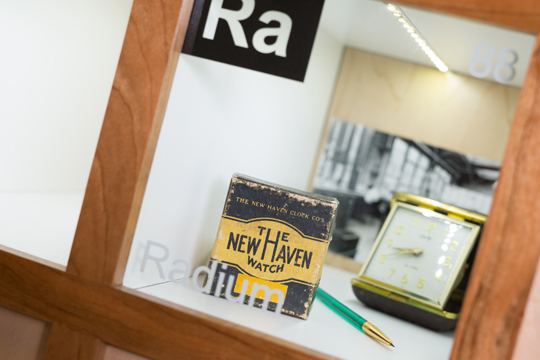It’s the first of its kind at a university or museum in Ohio and Michigan and possibly the only life-size periodic table in the world built and filled by a community.
The 800-pound, interactive periodic table bolted to the wall inside the main entrance to The University of Toledo’s Wolfe Hall features 118 LED-illuminated glass boxes.
Each box represents an element, and members of the community are invited to fill the boxes with examples of how each element relates to everyday life and current events.The display features touch-screen technology that allows visitors to explore a variety of apps that share stories and videos about the elements, contents of the element boxes, and who donated the items for each element.
The display titled “Living Science: The Ever-Changing Periodic Table” was funded by a $31,465 grant from UT’s Women & Philanthropy, a collaborative effort of area women and the University’s Division of Advancement that supports institutional initiatives.
“You’ll be surprised how you can relate to the periodic table,” said Dr. Kristin Kirschbaum, director of the UT Instrumentation Center, who worked for five years to bring this project to life. “This unique display is so inspiring — both visually and educationally — for anyone who walks through the doors. We want the whole community — not only chemists — to participate in filling it in.”
As part of the grant for the project, Kirschbaum can reimburse donors up to $50 for an item.“Through all of my research, this is the first and only community-built periodic table in the world,” Kirschbaum said. “We didn’t buy it pre-made with elements already inside. A local carpenter built this from scratch, and we are asking the public to help fill it up. We also will be able to regularly change the items in the boxes.”
Eight-year-old Destiny Zamora furnished the element box labeled “Au” with a gold-plated coin minted to celebrate the 100th year of Mexico’s independence, a gold medal, and a picture of Scrooge McDuck diving into his money vault.
“I chose gold because it’s my favorite color, and I want to be rich someday,” said the second-grader at Napoleon Elementary School whose father’s fiancee works in the College of Natural Sciences and Mathematics. “Did you know Olympic gold medals only contain 1.34 percent of gold?”
Alyson Lautar, a UT student studying pharmacy, donated a smoke detector to represent americium, which is made in nuclear reactors and was first produced in 1945 as part of the Manhattan Project. The symbol for the element on the periodic table is Am.
“Americium-241 is a vital ingredient in ionization-style smoke alarms, which are inside homes and help save lives in the event of a fire,” Lautar said. “A tiny piece of the radioactive americium can detect smoke. When americium-241 decays, it releases positively charged alpha particles. The alarm has two ionization chambers — one is closed to everything but the alpha particles, while the other is open to the air. Normally, these two ionization chambers would receive the same amount of positive charge, but if a small amount of smoke gets into the open chamber, the balance of charge between the chambers is thrown off and triggers the alarm.”
Dr. Steven Toth, a lecturer and lead expert at the University of Michigan in Flint who earned his bachelor’s degree and PhD in chemistry from UT, is donating a bottle of Flint water for the box representing lead to help teach about the city’s recent water crisis. The symbol for lead is Pb.“Lead used to be thought of as a ‘wonder’ chemical. It doesn’t store heat for nearly as long as other metals and has fast-drying powers, so it was used in pipes, paint and makeup,” Toth said. “We now know that lead can be toxic, and pretty much all products are sold lead-free. However, people in Flint were drinking water with high levels of lead after the city changed the water source in 2014. The city treated the water with chlorine to kill bacteria, and the chlorine started leaching lead out of the older, lead-lined pipes.”
Joe Slater, labor and employment law expert and the Eugene N. Balk Professor of Law and Values in the UT College of Law, designed the radium display that contains an old alarm clock, paint brush, New Haven watch box, black-and-white factory photo, description of legal cases, and program from the play titled “Radium Girls.” Radium’s symbol is Ra on the periodic table.

The display in the radium box was created by Joe Slater, the UT Eugene N. Balk Professor of Law and Values.
Matt Hafner, the local carpenter who built the massive periodic table in seven weeks, wants to do something for hafnium simply because it’s similar to his last name. Hafnium is Hf on the periodic table.
“While researching hafnium, I discovered it is used in tips of plasma torches,” said Hafner, owner of MDH Construction in Maumee. “I have one of those torches, so I’m considering making a video of how they are used on construction projects.”
Only a small handful of the element boxes contain items. A toy-sized Tin Man from “The Wizard of Oz” stands behind the glass labeled “Sn.”
A radiologist supplied a small bottle of gadodiamide, a gadolinium (Gd) that is used as a contrast agent in MRIs. Gadolinium’s box also contains a CD and the magnetic Pokémon called Magneton as it’s one of the few magnetic elements.
“We’re hoping the community will help us fill the empty element boxes,” Kirschbaum said. “Sparkplugs could be used for iridium (Ir), a tool set or dietary supplement for vanadium (V), dynamite for nitrogen (N). It can be anything from the pure element to something related to it. The possibilities are endless.”
To make a contribution to the periodic table, contact Kirschbaum at kristin.kirschbaum@utoledo.edu or 419.530.7847.
For more information, go to utoledo.edu/nsm/ic/periodictable.html.